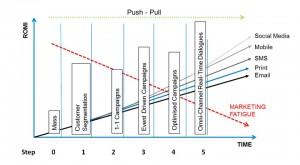
As a customer intelligence adviser, my work exposes me to a wide range of organizations with various marketing challenges and available resources. Over time, some common themes have emerged, one of which is omni-channel marketing as a business imperative. Changes in the ways customers engage with brands across an explosion of channels have prompted the need for organizations to engage in omni-channel marketing.
Best practices are starting to emerge for mastering omni-channel marketing, and I've seen that they seem to fall into a five-step pattern, which I will lay out for you in this short blog series titled, Five steps to omni-channel marketing.
In the previous posts in this series (Five steps to omni-channel marketing-step one, Five steps to omni-channel marketing – step two) I explained how you can move as an organization from mass marketing to segmented marketing and then from segmented marketing to one-to-one marketing. My goal in this post is to take you from one-to-one marketing to event-driven marketing.
Step 3: From one-to-one marketing to event-driven marketing
It’s important to understand that marketing has changed due to the growth of connected devices. Customers are using more and more disruptive customer journeys to engage with you as an organization. These disruptive customer journeys are being influenced by different signals and events. When doing event driven marketing the goal is to process the triggers and use them for marketing campaigns.
The difference with previously discussed marketing techniques is that it will focus more on pull marketing than push marketing. In other words, Event driven marketing is focused on trying to detect changes in the customer's needs and act on it with pre-defined campaigns. To be able to detect changes in a customer’s needs, it’s important that you:
- Listen to all the customer touch points.
- Catch and trap all the events.
- Understand how you need to combine signals that can form a possible event.
- Track which events are significant.
- Understand how you need to react on each event.
To make it more tangible I would like to share an anonymized example of an event-driven marketing project we did for one of our banking customers in Southwest Europe. The business problem of the bank was that they had a low amount of leads for mortgages. The called SAS to help find ways to improve the amount of prospects willing to make an appointment at the bank office.
One of the first things we did for the bank is looked at the customer journey for a mortgage. In the example below we defined the possible interactions a customer could have with the organization when looking for a mortgage. Most of the mortgage journeys start online as people start comparing banks before making a specific appointment.
Together with the bank we defined 6 online triggers which would would be used as an event to engage on with the customer. For each key trigger we defined an appropriate response depending on how far they are in the customer journey. To detect the maturity of a customer we gave them different points if they had exhibited certain behaviors. You can find an example of the points they would get below.
 By using points we would be able to identify where the customer was in the customer journey. Our idea was that as long as they didn’t make more than 2 mortgage simulations we would send them more informative messages, such as:
By using points we would be able to identify where the customer was in the customer journey. Our idea was that as long as they didn’t make more than 2 mortgage simulations we would send them more informative messages, such as:
- Which types of credits they currently have.
- What they should take into account when applying for a loan.
- Details on the current standard interest rates for a mortgage,
- How to use the mortgage calculator,
- Which are the available loan periods.
- If the customer was known we could give more personal interest rate (depending on his risk profile).
Once they did more than 2 mortgage simulations we would send them more targeted campaigns with the goal to fix an appointment with an agent. Using analytics we found that customers were more responsive when having done more than 2 mortgage calculations.
Research done by the university of Rotterdam has shown that event based marketing is far more effective than traditional email campaigns.
Convinced? Ready for the event driven marketing approach? A great next step would be for you to read the SAS Marketing Automation fact sheet. Or you're always welcome to contact us to make an appointment with one of our business advisors. In the meantime, stay tuned for my next post, where I will take you to optimization, the next step toward omni-channel marketing.

